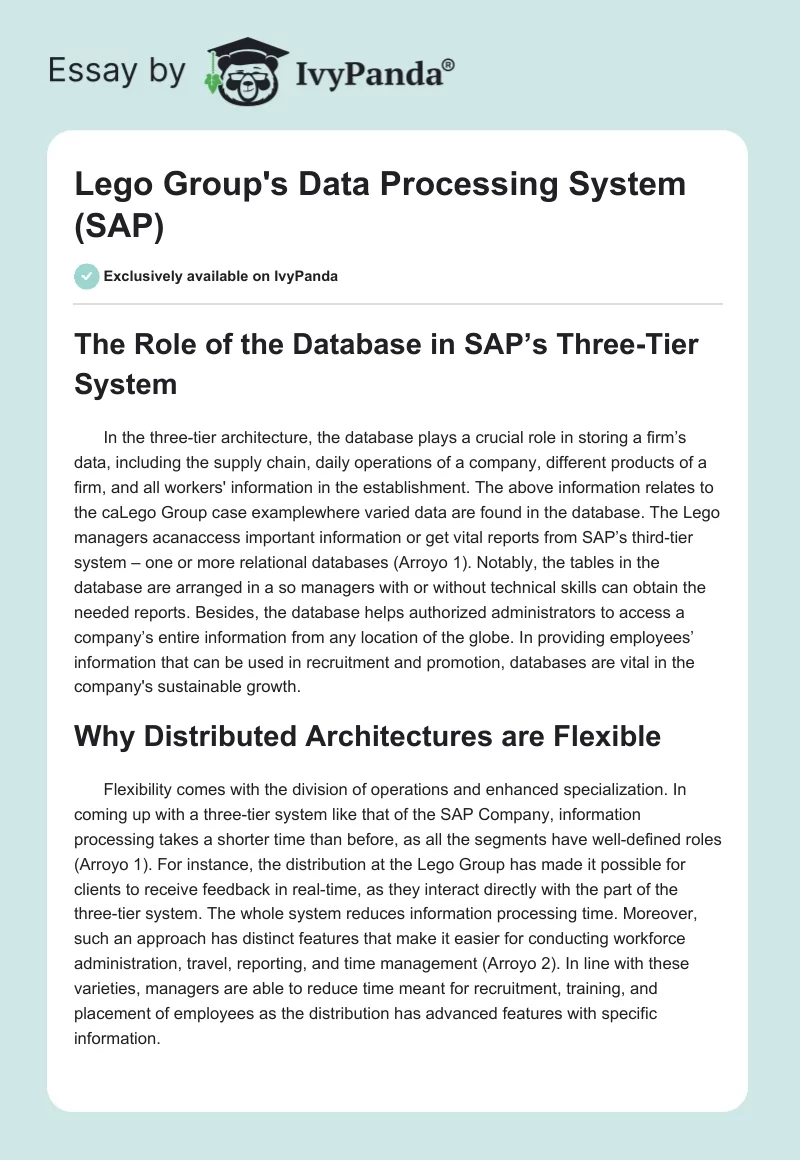The Role of the Database in SAP’s Three-Tier System
In the three-tier architecture, the database plays a crucial role in storing a firm’s data, including the supply chain, daily operations of a company, different products of a firm, and all workers’ information in the establishment. The above information relates to the category Lego Group case example where varied data are found in the database.
The Lego managers can access important information or get vital reports from SAP’s third-tier system – one or more relational databases (Arroyo 1). Notably, the tables in the database are arranged in a so managers with or without technical skills can obtain the needed reports. Besides, the database helps authorized administrators to access a company’s entire information from any location of the globe. In providing employees’ information that can be used in recruitment and promotion, databases are vital in the company’s sustainable growth.
Why Distributed Architectures Are Flexible
Flexibility comes with the division of operations and enhanced specialization. In coming up with a three-tier system like that of the SAP Company, information processing takes a shorter time than before, as all the segments have well-defined roles (Arroyo 1). For instance, the distribution at the Lego Group has made it possible for clients to receive feedback in real-time, as they interact directly with the part of the three-tier system. The whole system reduces information processing time. Moreover, such an approach has distinct features that make it easier for conducting workforce administration, travel, reporting, and time management (Arroyo 2). In line with these varieties, managers are able to reduce time meant for recruitment, training, and placement of employees as the distribution has advanced features with specific information.
Business Intelligence Features in SAP’s Business Software
The ability of the system to allow authorized personnel to access the company’s information in Asia, North America, and Europe present a unique business intelligence feature of the location. The officials can view the company’s performance in any region. In addition, the software has an executive dashboard. Managers can easily select, hire, and promote employees with the right skills (Arroyo 2). Organization of training occurs faster as business leaders have reliable information in real time.
With the availability of relevant and conscious data, executives can easily make binding decisions quickly. The metadata layer is also evident in SAP’s Business Software. This is evidenced by the ability of skilled and unskilled managers to operate the SAP query tool to retrieve valuable information from the databases. There is no need to understand the underlying data, as they are presented in simple business language. The possibility of analyzing HR trends as well as tracking employees’ leadership capability signifies the presence of a “what if” analysis feature. Managers can easily forecast and recruit the right employees for the organization (Arroyo, 2).
Advantages of Multiple Databases
Multiple databases can be accessed from different networks as opposed to a centralized and single database. The distribution of databases ensures continuity of operations even with the failure of one communication link. Moreover, the option in the distributed architecture increases the accessibility of data from any location since there is no control from the main office, as in the case of the Lego Group in Billund, Denmark (Arroyo 1). Overall, the option reduces operational costs and improves efficiency. The Lego Group data can be viewed and adjusted from any location in North America, Europe, and Asia (Arroyo 1).
Disadvantages
Even though multiple databases have the discussed merits, the option has some setbacks too. Since anybody can access and change data in the system from any site within the network, the distributed architecture has less security. Additionally, the system requires high maintenance cost given that system to establish a reliable network between different sites; there must be additional hardware. Even though the management cost at the Lego Group went down tremendously with the reduction in the number of employees, the adoption of multiple databases is not cost-effective as well.
Works Cited
Arroyo, Daniel Ortiz. Lego: Embracing Change by Combining BI with a Flexible Information System. 2007. Web.


